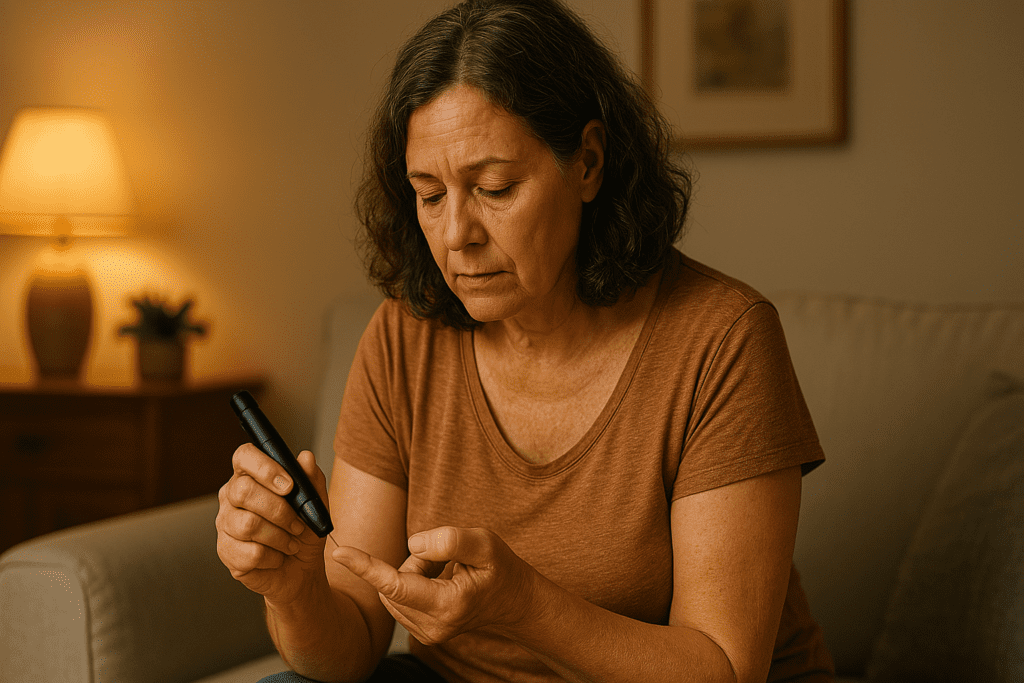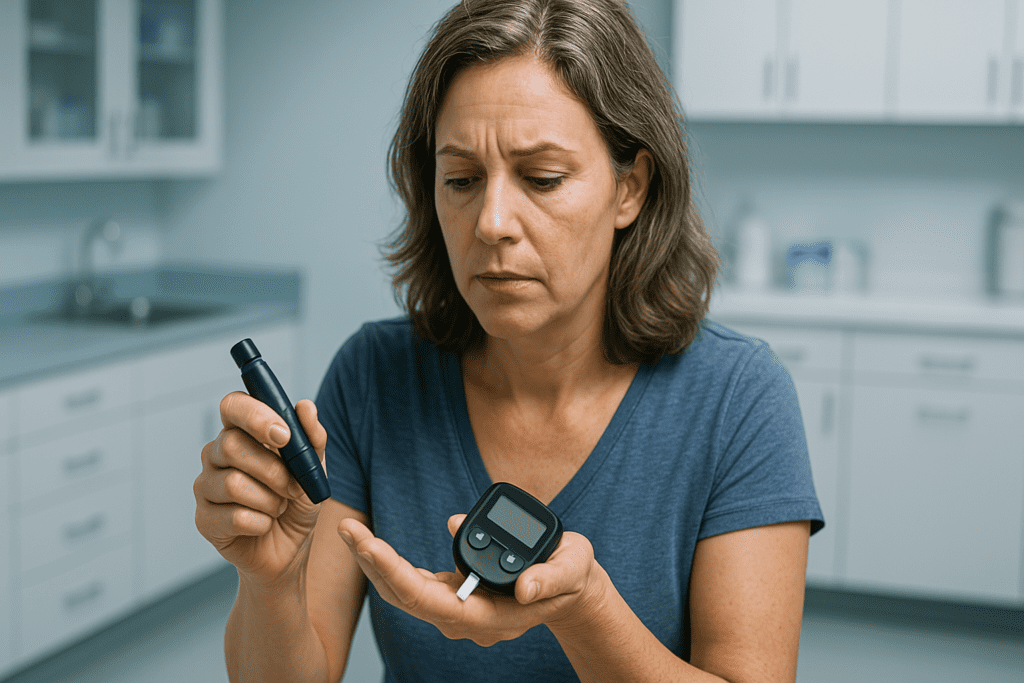Understanding the Silent Rise of Diabetes in Midlife Women
Diabetes is no longer a condition that solely affects older adults or those with overt health risks. In recent years, emerging research has revealed a troubling trend: women over 40 are increasingly being diagnosed with type 2 diabetes, often without realizing they were at risk. This silent escalation is driven by a combination of hormonal shifts, lifestyle changes, and genetic predispositions that become more pronounced during midlife. For many, the earliest diabetes symptoms go unnoticed or are dismissed as signs of aging or stress, delaying diagnosis and complicating management.
You may also like: Breakthroughs in Current Diabetes Research: What the Latest Studies Reveal About Treatment and Prevention
This article delves into the early signs of diabetes in women over 40, focusing on how subtle symptoms may reveal deeper metabolic imbalances. It also explores what causes diabetes in midlife, the stages of type 2 diabetes progression, and what the latest medical research says about early detection and long-term prevention. By shedding light on these findings, we aim to empower readers with the tools to recognize early warning signs and take proactive steps toward better health.
What Is Diabetes and Why It Often Goes Undiagnosed in Women
At its core, diabetes mellitus is a chronic metabolic disorder characterized by elevated blood glucose levels resulting from impaired insulin production or action. The two primary forms are type 1 and type 2 diabetes, with the latter being far more common in adults. Type 2 diabetes occurs when the body becomes resistant to insulin or when the pancreas fails to produce sufficient insulin to regulate glucose effectively. While type 1 is often diagnosed in childhood, type 2 diabetes tends to develop gradually, making it harder to detect in its early stages.
In women, especially those over 40, the symptoms of type 2 diabetes may not present as dramatically as in men. Fluctuations in hormones during perimenopause and menopause can mask or mimic diabetes symptoms, such as fatigue, weight gain, mood changes, and irregular sleep. As a result, women may attribute these changes to aging or hormonal imbalances rather than investigating the possibility of diabetes. Understanding what is diabetes and how it affects the body becomes crucial for identifying its early manifestations in female patients.

The Unique Signs of Diabetes in Women Over 40
Recognizing the signs of diabetes in women over 40 requires a nuanced understanding of how this condition manifests in the context of hormonal shifts and midlife health changes. Unlike the more obvious symptoms often seen in younger individuals or in men, women may experience vague or non-specific issues. Common diabetes symptoms in women include persistent fatigue, frequent urination, unexplained weight fluctuations, increased thirst, and blurry vision. These may be subtle enough to go unnoticed for months or even years.
More uniquely, signs of type 2 diabetes in women can also include recurrent yeast infections, urinary tract infections, and dry, itchy skin. Hormonal changes during perimenopause may worsen insulin sensitivity, leading to more erratic blood sugar levels and making early signs harder to track. Some women might notice changes in their appetite, mental clarity, or even increased irritability without connecting these symptoms to blood sugar regulation issues. These early warning signs are not just inconvenient; they may represent the body’s escalating struggle to maintain glucose balance.
How Does Diabetes Affect the Body Differently in Women?
The systemic nature of diabetes means it can affect nearly every organ in the body, but its impact may vary significantly between men and women. In women over 40, who are often navigating perimenopausal or menopausal transitions, the effects of diabetes can be amplified. For instance, estrogen plays a protective role in glucose metabolism and cardiovascular health. As estrogen levels decline, insulin resistance tends to increase, exacerbating the risk of type 2 diabetes and its complications.
Over time, uncontrolled diabetes symptoms can lead to damage in blood vessels, nerves, kidneys, and the eyes. Women may also face a heightened risk of heart disease, stroke, and bone density loss. Importantly, type 2 diabetes symptoms in women can overlap with those of other conditions like thyroid disorders or adrenal fatigue, complicating diagnosis. This overlap underscores the importance of comprehensive screening protocols for women experiencing chronic fatigue, weight gain, or other metabolic symptoms, particularly when standard treatments fail to yield results.
What Causes Diabetes and Why Are Women Over 40 More Vulnerable?
Understanding what causes diabetes involves examining both genetic and environmental influences. In type 2 diabetes, the primary contributors include insulin resistance, beta-cell dysfunction, and chronic inflammation, often driven by diet, sedentary lifestyle, obesity, and aging. Hormonal changes in women—especially around age 40 and beyond—create a physiological environment that favors insulin resistance. Reduced estrogen, increased cortisol, and alterations in body fat distribution all contribute to heightened risk.
Furthermore, how someone gets diabetes can be influenced by social determinants of health, such as access to nutritious food, opportunities for physical activity, healthcare access, and chronic stress. In many cases, a woman may ask herself, “Can I have diabetes even if I feel mostly fine?” The answer, increasingly, is yes. Because early-stage diabetes often presents with few or vague symptoms, women may live for years with undiagnosed insulin resistance, setting the stage for eventual complications. By better understanding the root causes of diabetes, clinicians and patients can prioritize early lifestyle interventions and more targeted screenings.

Stages of Type 2 Diabetes: From Insulin Resistance to Complications
Diabetes does not develop overnight. Instead, it typically progresses through several identifiable stages, beginning with insulin resistance. This condition, often marked by fatigue after meals, sugar cravings, and abdominal weight gain, indicates that the body is struggling to use insulin effectively. At this stage, fasting glucose levels may still appear normal, making diagnosis difficult unless an oral glucose tolerance test or HbA1c screening is performed.
As insulin resistance intensifies, prediabetes may develop. Here, blood glucose levels are elevated but not yet high enough to meet the diagnostic threshold for type 2 diabetes. Without lifestyle changes or medical intervention, full-blown type 2 diabetes eventually emerges. The stages of type 2 diabetes are not always linear, and the speed of progression varies from person to person. However, once diabetes becomes established, the risk of complications such as neuropathy, nephropathy, and retinopathy increases significantly, particularly in those with uncontrolled blood sugar levels.
Identifying Uncontrolled Diabetes Symptoms Early
One of the greatest challenges in diabetes care is identifying symptoms before they become unmanageable. Uncontrolled diabetes symptoms may include chronic fatigue, extreme thirst, frequent infections, slow-healing wounds, numbness in the extremities, and vision changes. In some cases, symptoms of type 2 diabetes in men over 50 or symptoms of type 2 diabetes in males may receive more attention due to clearer diagnostic patterns. However, the more insidious presentation in women over 40 often leads to delayed intervention.
When blood glucose levels remain persistently high, the damage can be cumulative and irreversible. Recognizing the signs of diabetes early—especially when they manifest subtly in midlife women—can mean the difference between manageable health and serious complications. Physicians should ask more nuanced questions during check-ups, particularly when patients report sleep issues, chronic stress, brain fog, or other seemingly unrelated concerns. For patients, understanding what happens if type 2 diabetes goes untreated may be a wake-up call for timely action.
Can You Get Rid of Type 2 Diabetes or Is It a Lifelong Condition?
The question of whether type 2 diabetes is curable is both medically significant and deeply personal. While the term “cure” is debated, numerous studies suggest that it is possible to achieve remission—especially when lifestyle changes are made early in the disease process. In recent years, clinical trials have demonstrated that significant weight loss, particularly through dietary modification and increased physical activity, can reverse insulin resistance and restore normal glucose regulation in many individuals.
That said, whether one can get rid of type 2 diabetes depends on a host of factors including disease duration, genetic predisposition, and adherence to treatment. The belief that type 2 diabetes is curable may inspire hope, but it also necessitates long-term commitment. Blood sugar levels may normalize, but ongoing monitoring remains essential. For many women over 40, remission is achievable through dedicated efforts in nutrition, exercise, stress management, and metabolic health. While there is no one-size-fits-all answer to the question, “Can you get rid of type 2 diabetes?” the path to remission is increasingly supported by scientific evidence.
Latest Research Findings on Diabetes Symptoms in Women
Recent research has illuminated key differences in how diabetes symptoms manifest in women compared to men. For instance, a study published in The Lancet Diabetes & Endocrinology found that women are more likely to present with atypical symptoms and to be misdiagnosed or diagnosed later than men. The early signs of diabetes in women—such as fatigue, mood changes, and bladder infections—are often attributed to hormonal fluctuations or psychological stress rather than metabolic dysfunction.
Another body of research explores how estrogen interacts with insulin and glucose metabolism. Reduced estrogen levels are linked to increased abdominal fat, inflammation, and altered lipid profiles—all of which contribute to higher diabetes risk. This hormonal link underscores why diabetes symptoms in women may intensify during midlife. The latest research also investigates the role of gut microbiota, mitochondrial function, and genetic polymorphisms in influencing how type 2 diabetes symptoms develop and progress in women. These insights not only deepen our understanding of the condition but also pave the way for more personalized and sex-specific interventions.
Why Early Detection Is Critical for Women’s Long-Term Health
Early detection of diabetes provides a crucial opportunity to halt or even reverse disease progression. For women over 40, identifying the signs of diabetes early may reduce the likelihood of cardiovascular complications, kidney disease, and neurological damage later in life. It also allows for the implementation of lifestyle modifications when they are most effective. Unfortunately, because many early symptoms overlap with other midlife health concerns, women are often overlooked during routine screening.
Healthcare providers are increasingly encouraged to consider broader screening criteria for midlife women, even those without classic risk factors such as obesity or family history. Asking the right questions—about energy levels, mental focus, menstrual changes, skin health, and sleep quality—can reveal early indicators of metabolic dysfunction. The long-term benefits of early detection include improved quality of life, reduced healthcare costs, and lower risk of disability. Understanding how diabetes affects the body and what happens if type 2 diabetes goes untreated should motivate both clinicians and patients to prioritize early evaluation.
Taking Action: Prevention, Screening, and Empowerment
Preventing type 2 diabetes is not merely about avoiding sugar or taking medication. It requires a holistic approach that includes diet, movement, sleep hygiene, stress reduction, and regular health screenings. For women over 40, this may also mean working closely with healthcare providers to monitor hormonal shifts, cardiovascular health, and weight fluctuations. Knowing how to develop diabetes and how can one get diabetes helps in understanding the small but cumulative lifestyle choices that lead to insulin resistance.
Tools such as continuous glucose monitors, personalized nutrition plans, resistance training, and mindfulness practices are increasingly part of comprehensive diabetes prevention programs. Community education initiatives, digital health platforms, and wearable technologies now empower women to take charge of their metabolic health like never before. By demystifying what is the real cause of diabetes and separating myths from science, these interventions can improve early outcomes and promote sustainable wellness practices.

Frequently Asked Questions: Early Signs of Diabetes in Women Over 40
What are some lesser-known signs of diabetes in women that may be mistaken for aging or stress?
While common diabetes symptoms like excessive thirst and frequent urination are widely recognized, many early signs of diabetes in women are subtle and often mistaken for age-related changes. For example, persistent brain fog, disrupted sleep patterns, or unexpected mood swings might not immediately raise concern, but they can signal blood sugar instability. Some women report changes in libido or increased skin pigmentation, especially around the neck or underarms, known as acanthosis nigricans—a potential early marker of insulin resistance. These signs of diabetes may not trigger alarm bells but are worth discussing with a healthcare provider, especially when accompanied by fatigue or unexplained weight gain. Understanding that diabetes symptoms in women can manifest differently than in men helps prevent misdiagnosis and delayed treatment.
Can hormonal changes during perimenopause accelerate how someone gets diabetes?
Yes, hormonal shifts during perimenopause can significantly influence how someone gets diabetes. Fluctuations in estrogen and progesterone can impair insulin sensitivity, leading to spikes and crashes in blood glucose levels. This hormonal turbulence increases the likelihood of developing type 2 diabetes in midlife women, especially when combined with weight gain, stress, and decreased physical activity. Many women are unaware that these hormonal imbalances can mimic or mask early signs of diabetes in women over 40, such as fatigue, irritability, or poor concentration. Recognizing this connection between hormonal change and metabolic disruption is critical in preventing and managing diabetes mellitus during midlife.
Is there a psychological impact associated with the early stages of type 2 diabetes in women?
Absolutely. The early stages of type 2 diabetes can bring a psychological burden that often goes unaddressed. Women experiencing signs of type 2 diabetes in women, such as fatigue or cognitive fog, may feel guilt, frustration, or anxiety over their perceived inability to manage their health. These feelings are compounded by the slow and often invisible nature of type 2 diabetes symptoms, leading many to doubt or dismiss their own experiences. Research has shown that untreated diabetes symptoms can contribute to depression and reduced self-efficacy in women, which may worsen blood sugar control. Addressing both the physical and emotional toll of developing diabetes is essential for holistic care and sustained lifestyle change.
Why do symptoms of type 2 diabetes in men over 50 get diagnosed more readily than in women?
The diagnosis of symptoms of type 2 diabetes in men over 50 tends to be more straightforward due to clearer presentation and earlier screening. Men are more likely to exhibit classic diabetes symptoms, such as abdominal obesity and high fasting glucose levels, which are often flagged during routine health checks. In contrast, type 2 diabetes symptoms in women may be subtle or atypical, including skin changes or chronic fatigue, and are more likely to be attributed to hormonal shifts or stress. Additionally, societal biases in healthcare sometimes lead to underdiagnosis of chronic conditions in women. Bridging this gap requires increased awareness of how diabetes symptoms women experience may diverge from traditional diagnostic models.
What are the social and occupational impacts of undiagnosed diabetes in midlife women?
Undiagnosed or uncontrolled diabetes symptoms can severely affect a woman’s ability to perform at work and manage social responsibilities. Signs of diabetes in women over 40, such as memory lapses, blurred vision, or low energy, may impair job performance, productivity, and interpersonal relationships. Fatigue can lead to absenteeism or difficulty maintaining focus in high-pressure roles, while physical symptoms may limit participation in activities or community life. The stigma associated with chronic illness can also cause women to avoid discussing their condition, leading to isolation or delayed care. Addressing these psychosocial dimensions is critical when exploring how to get rid of type 2 diabetes and prevent long-term complications.
How does diabetes affect the body differently depending on when it’s diagnosed?
The timing of diagnosis significantly impacts how diabetes affects the body. When caught early, especially in the prediabetic or insulin-resistant stages of type 2 diabetes, interventions can limit or reverse organ damage. However, when the condition goes undetected for years, complications such as neuropathy, retinopathy, and cardiovascular disease become more likely. In women, delayed detection can mean a greater impact on reproductive and bone health due to cumulative effects of chronic inflammation and hormonal dysregulation. This illustrates why identifying the stages of type 2 diabetes early is so critical. Whether one is asking, “Can I have diabetes if I feel mostly fine?” or wondering about vague symptoms, early testing and lifestyle modifications can preserve long-term health outcomes.
What new technologies are helping identify signs of diabetes in women earlier?
Innovations in digital health are revolutionizing early diabetes detection. Continuous glucose monitors (CGMs), wearable devices that track blood sugar in real-time, are becoming more accessible and user-friendly. These tools help detect erratic blood sugar patterns before type 2 diabetes symptoms become clinically apparent. Artificial intelligence algorithms can now assess risk based on lifestyle data, menstrual cycles, sleep patterns, and even voice biomarkers. For women, especially those over 40, these technologies can offer a clearer picture of how diabetes affects the body before traditional symptoms arise. As we better understand what is the real cause of diabetes at the cellular level, technology will play an increasing role in early and individualized care.
What practical strategies help prevent uncontrolled diabetes symptoms from progressing?
Preventing uncontrolled diabetes symptoms begins with small, consistent lifestyle shifts. Focusing on muscle-building activities, such as resistance training, can enhance insulin sensitivity and reduce inflammation. Nutrition strategies that emphasize fiber-rich foods, low-glycemic carbohydrates, and healthy fats are particularly effective in stabilizing blood sugar. Stress management is also critical, as chronic cortisol elevation can worsen glucose regulation and increase the risk of developing type 2 diabetes. Beyond diet and exercise, social support plays a powerful role in adherence to long-term health strategies. By targeting the root causes of diabetes and its triggers, these interventions help reduce the severity of symptoms and slow the progression across all stages of type 2 diabetes.
Why are some women unaware they have diabetes until complications occur?
Many women remain unaware of their diabetes until complications arise because early diabetes symptoms in women are often vague and overlap with other common conditions. Fatigue, mood changes, or increased urinary frequency can be mistaken for hormonal shifts, mental health challenges, or age-related decline. Routine screenings might overlook borderline glucose levels if more specific tests, such as HbA1c or glucose tolerance tests, aren’t administered. Additionally, cultural norms and caregiving roles often lead women to prioritize others’ health over their own, delaying self-care. A broader understanding of what causes diabetes in women—including socioeconomic and behavioral factors—can help shift both medical and personal attention to early intervention.
Is there a path toward remission, and will type 2 diabetes be cured one day?
While there is no definitive cure yet, type 2 diabetes remission is possible, especially when addressed early. Individuals who adopt rigorous lifestyle changes—such as significant weight loss, sustained physical activity, and targeted nutritional therapy—can reduce or eliminate the need for medication. For some, bariatric surgery has also shown promise in achieving remission by altering gut hormone responses. However, even in remission, vigilance is essential, as returning to old habits can lead to recurrence. Researchers continue to explore what is the root cause of diabetes at the molecular and genetic level, with the hope that future therapies may one day offer a permanent solution. For now, the question “Can you get rid of type 2 diabetes?” is best answered with cautious optimism supported by science and sustained lifestyle commitment.
The Road Ahead: Why Recognizing the Signs of Diabetes in Women Over 40 Could Save Lives
The road to prevention and early intervention starts with awareness. Recognizing the signs of diabetes in women over 40 is not just a matter of clinical precision—it’s a public health imperative. The earlier women understand how diabetes affects the body and identify symptoms of type 2 diabetes in males and females alike, the more empowered they become in managing their health. Midlife should not be a time of declining vitality but one of informed and proactive self-care.
What makes this issue urgent is that the onset of diabetes often marks the beginning of a cascade of other chronic diseases if left unchecked. From cardiovascular disease to neurodegenerative conditions, the metabolic shifts that define type 2 diabetes have far-reaching implications. But with new research, innovative screening tools, and lifestyle-based interventions, the tide is turning. The question is no longer just “How does someone get diabetes?” but rather “What can we do today to stop it tomorrow?”
For women navigating the complexities of midlife, understanding the early warning signs is the first step toward a healthier, more resilient future. Armed with the knowledge provided by science and supported by healthcare systems attuned to the nuances of gender and age, they can move confidently toward long-term well-being. And for the broader community, acknowledging the specific challenges of type 2 diabetes in women is a step toward more inclusive, effective public health strategies.
prediabetes in women, insulin resistance symptoms, midlife metabolic health, perimenopause and blood sugar, female hormone imbalance, early diabetes risk factors, blood sugar monitoring tools, menopause and insulin sensitivity, glucose intolerance signs, chronic fatigue and blood sugar, managing diabetes naturally, hormonal changes after 40, metabolic syndrome in women, lifestyle tips for blood sugar control, women’s health over 40, stress and glucose levels, digital health for diabetes, blood sugar and sleep disruption, aging and metabolic disorders, personalized diabetes prevention
Further Reading:
How Does Diabetes Affect Women Over the Age of 40?
What are the early signs of type 2 diabetes?
5 Things Women Need to Know About Diabetes and Their Period
Disclaimer
The information contained in this article is provided for general informational purposes only and is not intended to serve as medical, legal, or professional advice. While MedNewsPedia strives to present accurate, up-to-date, and reliable content, no warranty or guarantee, expressed or implied, is made regarding the completeness, accuracy, or adequacy of the information provided. Readers are strongly advised to seek the guidance of a qualified healthcare provider or other relevant professionals before acting on any information contained in this article. MedNewsPedia, its authors, editors, and contributors expressly disclaim any liability for any damages, losses, or consequences arising directly or indirectly from the use, interpretation, or reliance on any information presented herein. The views and opinions expressed in this article are those of the author(s) and do not necessarily reflect the official policies or positions of MedNewsPedia.


